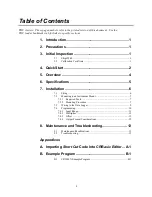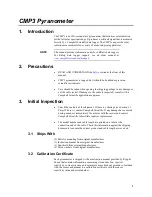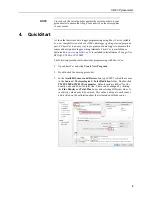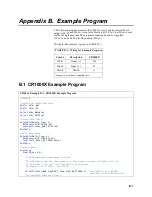
CMP3 Pyranometer
12
7.4.2 Multiplier
The multiplier converts the millivolt reading to engineering units. The
calibration supplied by the manufacturer gives the output of the sensor (c) as
microvolts per W/m^2. As the data logger voltage measurement instructions
give a default output in millivolts, the following equation should be used to
calculate the multiplier (m) to give the readings in W/m
2
:
m = 1000/c
Other units can be used by adjusting the multiplier as shown in TABLE
TABLE 7-2. Multipliers Required for Flux Density and Total Fluxes
Units
Multipliers
Output Processing
W/m
2
m
Average
MJ/m
2
m × t × 0.000001
Total
kJ/m
–2
m ×
t
× 0.001
Total
cal/cm
2
m × t × 0.0239 × 0.001
Total
cal/cm
2
/min
m × 1.434 × 0.001
Average
m = calibration factor in W/m
2
/mV
t = data logger program execution interval in seconds
7.4.3 Offset
The offset will normally be fixed at zero as the sensor should output no
significant signal in dark conditions. In practice, because of the nature of
thermopile detector sensors, there will be some offset in dark conditions;
sometimes this offset can give negative light readings. This offset varies with
several factors, such as rate of change of sensor temperature, so it cannot be
removed with a fixed offset. Some users may wish to remove small negative
readings by including code after the measurement instructions that sets
negative readings to zero.
7.4.4 Output Format Considerations
When using the Campbell Scientific floating point data format to store data, the
largest number the data logger can store in final storage is 6999 in low
resolution mode (FP2) and 99999 in high resolution mode (if available). If the
measurement value is totalized, there is some danger of over-ranging the output
limits. To avoid this issue, store the data in the in IEEE4 format, which can
represent a wider range of numbers.
8. Maintenance and Troubleshooting
All factory repairs and recalibrations require a returned material
authorization (RMA) and completion of the “Declaration of
Hazardous Material and Decontamination” form. Refer to the
page at the beginning of this manual for more
information.
NOTE























